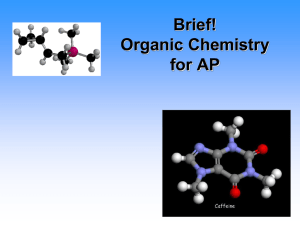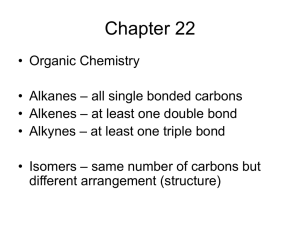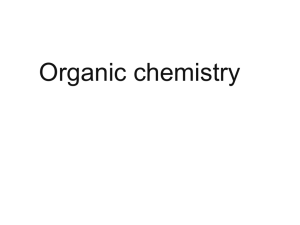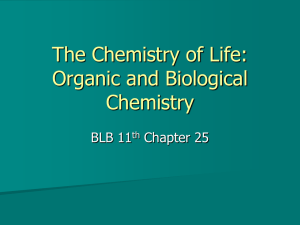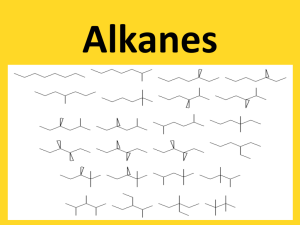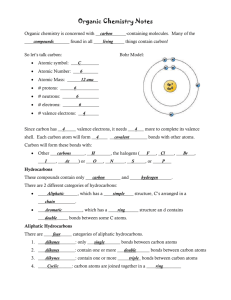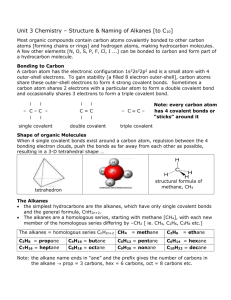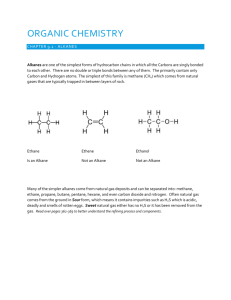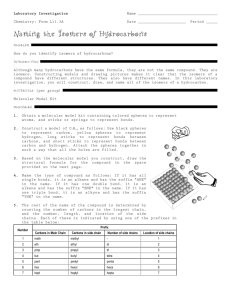Organic - Chemistry Geek
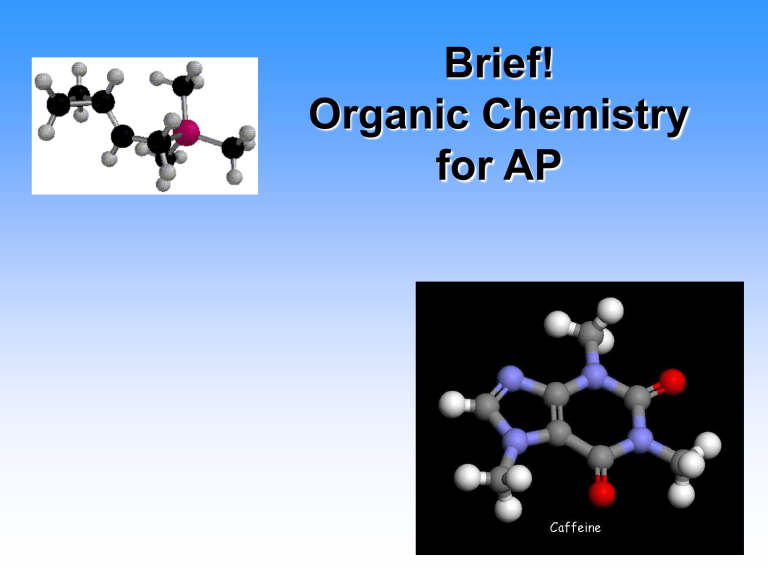
Brief!
Organic Chemistry for AP
Alkanes
• Hydrocarbon chains where all the bonds between carbons are SINGLE bonds
• Name uses the ending – ane
• Examples: Meth ane , Prop ane , But ane ,
Oct ane , 2-methylpent ane
Prefixes for # of Carbons
1 Meth 6 Hex
2 Eth
3 Prop
4 But
5 Pent
7 Hept
8 Oct
9 Non
10 Dec
Endings
• Alkanes (all C-C single bonded parent chain) end in –ane
– Meth ane CH
4
– Eth ane C
2
H
6
– Prop ane C
3
H
8
• Attached carbon groups (substituents) end in –yl
– Meth yl CH
3
-
– Eth yl CH
3
CH
2
-
– Prop yl CH
3
CH
2
CH
2
–
3-ethyl pentane
Names of attached groups
• Carbon (alk yl ) groups
– Meth yl CH
3
-
– Eth yl CH
3
CH
2
-
– Prop yl CH
3
CH
2
CH
2
–
• Halogens
– Fluoro (F-)
– Chloro (Cl-)
– Bromo (Br-)
– Iodo (I-)
Designate the Location
• Designate the location (number of the carbon on the parent chain) for each attached group
2-methyl
1 2 3 4 5
Some Simple Alkanes
• 2-methylpentane
• 3-ethylhexane
• 2,2-dimethylbutane
• 2,3-dimethylbutane
Structural Formulas
• “Lazy” way to write the Hydrogens
• Instead of drawing the bonds, just state how many hydrogens are attached
• NOTE: The bonds are between
CARBONS in a parent chain, and not hydrogens!
Structural Formula
Lewis Structure
Drawing and Naming Cycloalkanes
Cycloalkanes are represented by polygons.
A triangle represents cyclopropane, a square represents cyclobutane, a pentagon represents cyclopentane, and so on.
Isomers
• Straight chain alkanes: An alkane that has all its carbons connected in a row.
• Branched chain alkanes: An alkane that has a branching connection of carbons.
• Isomers: Compounds with same molecular formula but different structures.
• However, carbons in butane (C
4
H
10
) can be arranged in two ways; four carbons in a row (linear alkane) or a branching
(branched alkane). These two structures are two isomers for butane.
•Different isomers are completely different compounds.
They have different structures, different physical properties such as melting point and boiling point, and may have different physiological properties.
Learning Check
• Draw all possible structural isomers of C
5
H
12
Alkenes and Alkynes
• Unsaturated
– contain carbon-carbon double and triple bond to which more hydrogen atoms can be added.
• Alkenes: carbon-carbon double bonds
• Alkynes: carbon-carbon triple bonds.
Naming Alkenes and Alkynes
When the carbon chain has 4 or more C atoms, number the chain to give the lowest number to the double or triple bond.
1 2 3 4
CH
2
=CHCH
2
CH
3
1-butene
2-butene CH
3
CH=CHCH
3
CH
3
C
CCH
3
2-butyne
Aromatic Compounds and
Benzene
Aromatic compounds contain benzene.
Benzene, C
6
H
6
, is represented as a six carbon ring with 3 double bonds.
H
Two possible resonance structures can be drawn to show benzene in this form.
H H
H
H H
H
H H H
H H
